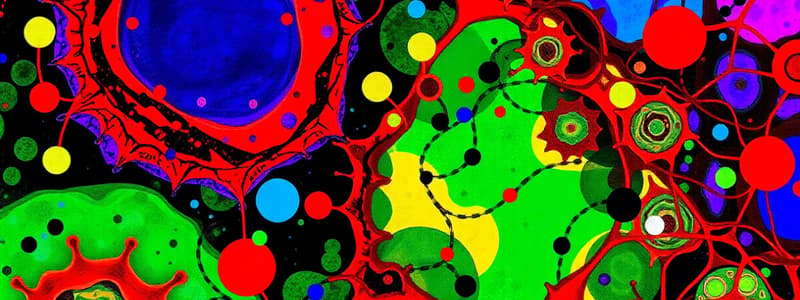Podcast
Questions and Answers
What byproduct is generated during the hydrolysis of water in the light dependent reactions?
What byproduct is generated during the hydrolysis of water in the light dependent reactions?
Which molecule is primarily responsible for carrying energy during the light independent reactions?
Which molecule is primarily responsible for carrying energy during the light independent reactions?
In cellular respiration, what is the main difference between aerobic and anaerobic respiration?
In cellular respiration, what is the main difference between aerobic and anaerobic respiration?
What is the primary reactant converted into sugar during the light independent reactions?
What is the primary reactant converted into sugar during the light independent reactions?
Signup and view all the answers
What drives the movement of H+ across the membrane during the light dependent reactions?
What drives the movement of H+ across the membrane during the light dependent reactions?
Signup and view all the answers
What is the primary advantage of a light microscope compared to an electron microscope?
What is the primary advantage of a light microscope compared to an electron microscope?
Signup and view all the answers
Which of the following statements correctly describes prokaryotic cells?
Which of the following statements correctly describes prokaryotic cells?
Signup and view all the answers
What part of the prokaryotic cell is responsible for regulating the entry and exit of substances?
What part of the prokaryotic cell is responsible for regulating the entry and exit of substances?
Signup and view all the answers
Which eukaryotic cell structure is responsible for dividing the cytoplasm into compartments?
Which eukaryotic cell structure is responsible for dividing the cytoplasm into compartments?
Signup and view all the answers
New cells arise from which of the following processes?
New cells arise from which of the following processes?
Signup and view all the answers
What is the main disadvantage of using a scanning electron microscope (SEM)?
What is the main disadvantage of using a scanning electron microscope (SEM)?
Signup and view all the answers
What function does the capsule of a prokaryotic cell serve?
What function does the capsule of a prokaryotic cell serve?
Signup and view all the answers
What is a key characteristic of eukaryotic cells that differentiates them from prokaryotic cells?
What is a key characteristic of eukaryotic cells that differentiates them from prokaryotic cells?
Signup and view all the answers
Which of the following cell structures is considered an organelle involved in protein synthesis?
Which of the following cell structures is considered an organelle involved in protein synthesis?
Signup and view all the answers
Which type of microscope would be best to observe the fine details inside a cell?
Which type of microscope would be best to observe the fine details inside a cell?
Signup and view all the answers
Which type of inhibition involves substances that bind to the active site of an enzyme?
Which type of inhibition involves substances that bind to the active site of an enzyme?
Signup and view all the answers
What is true about allosteric inhibitors?
What is true about allosteric inhibitors?
Signup and view all the answers
Which statement is correct about exergonic and endergonic reactions?
Which statement is correct about exergonic and endergonic reactions?
Signup and view all the answers
How do enzymes primarily lower activation energy?
How do enzymes primarily lower activation energy?
Signup and view all the answers
What distinguishes catabolic pathways from anabolic pathways?
What distinguishes catabolic pathways from anabolic pathways?
Signup and view all the answers
What are the three stages of aerobic respiration?
What are the three stages of aerobic respiration?
Signup and view all the answers
Where does glycolysis occur in a cell?
Where does glycolysis occur in a cell?
Signup and view all the answers
Which of the following is a product of the Krebs cycle?
Which of the following is a product of the Krebs cycle?
Signup and view all the answers
How many ATP are produced during oxidative phosphorylation?
How many ATP are produced during oxidative phosphorylation?
Signup and view all the answers
What type of fermentation occurs in skeletal muscle?
What type of fermentation occurs in skeletal muscle?
Signup and view all the answers
Which process produces less ATP than aerobic respiration?
Which process produces less ATP than aerobic respiration?
Signup and view all the answers
What is the final electron acceptor in aerobic respiration?
What is the final electron acceptor in aerobic respiration?
Signup and view all the answers
Which of the following correctly describes the efficiency of anaerobic respiration compared to aerobic respiration?
Which of the following correctly describes the efficiency of anaerobic respiration compared to aerobic respiration?
Signup and view all the answers
What describes an amphipathic molecule?
What describes an amphipathic molecule?
Signup and view all the answers
Which of the following is NOT a main component of cellular membranes?
Which of the following is NOT a main component of cellular membranes?
Signup and view all the answers
What is the function of self-markers in cells?
What is the function of self-markers in cells?
Signup and view all the answers
Which statement accurately describes moving 'with' the concentration gradient?
Which statement accurately describes moving 'with' the concentration gradient?
Signup and view all the answers
Which type of passive transport requires a protein channel?
Which type of passive transport requires a protein channel?
Signup and view all the answers
What is a characteristic of exergonic reactions?
What is a characteristic of exergonic reactions?
Signup and view all the answers
Which component is essential for freshwater protists to prevent cell bursting?
Which component is essential for freshwater protists to prevent cell bursting?
Signup and view all the answers
What role do enzymes play in chemical reactions?
What role do enzymes play in chemical reactions?
Signup and view all the answers
What effect do non-competitive inhibitors have on enzyme function?
What effect do non-competitive inhibitors have on enzyme function?
Signup and view all the answers
Which of the following statements about metabolic pathways is true?
Which of the following statements about metabolic pathways is true?
Signup and view all the answers
Study Notes
Cell Theory
- All living organisms consist of cells.
- Cells are the smallest unit of life.
- New cells originate from pre-existing cells through division.
Microscopy
- Two main types:
- Light microscope: Uses light for illumination, magnification up to 1000-2000x; can view living organisms but has limited magnification for small structures.
- Electron microscope: Uses a beam of electrons for illumination, magnification up to 20,000-100,000x.
- Scanning Electron Microscope (SEM): High magnification view, but only surface details.
- Transmission Electron Microscope (TEM): Views internal structures of cells, but requires thin slices.
Cell Structures
- All cells contain four essential structures: plasma membrane, cytoplasm, genetic material, and ribosomes.
- Organelles, termed "little organs," perform specific functions within the cell.
Basic Cell Types
- Prokaryotic cells ("before the nucleus"):
- Simple structure, lack a nuclear membrane.
- Eukaryotic cells ("true nucleus"):
- More complex, possess a nuclear membrane around DNA.
Prokaryotic Cells
-
Two categories:
- Bacteria: Small (1 μm – 10 μm), diverse, mostly non-harmful, but some cause diseases.
- Archaea: Similar size, less common, often found in extreme environments.
-
Structure includes:
- Plasma membrane: Regulates substance exchange.
- Cytoplasm: Contains internal components.
- Nucleoid region: Location of genetic material.
- Ribosomes: Synthesize proteins.
- Cell wall: Provides rigidity and shape.
- Capsule: Offers protection and helps evade immune response.
- Pili and Flagella: Functions in attachment and locomotion respectively.
Eukaryotic Cells
- Vary in shape, size, and organization based on type and species.
- DNA is enclosed within the nucleus.
- Membrane-bound organelles compartmentalize cellular functions.
Structures:
- Plasma membrane: Controls substance movement, facilitates cell adhesion, and signal transduction.
- Cytoplasm: Composed of cytosol and organelles.
Cellular Respiration
- Two types:
- Aerobic respiration: Requires oxygen, highly efficient for ATP production.
- Anaerobic respiration: Occurs without oxygen, less efficient, primarily in some prokaryotes.
Aerobic Respiration Stages:
- Glycolysis: Occurs in the cytoplasm, breaks glucose into two molecules, yielding 2 ATP.
- Krebs Cycle: Takes place in mitochondria, converts pyruvate into ATP and electron carriers (NADH, FADH2).
- Oxidative Phosphorylation: Involves a series of proteins in the inner mitochondrial membrane, producing 32-34 ATP by creating a proton gradient.
Anaerobic Respiration:
- Uses different final electron acceptors other than oxygen; produces 2 ATP.
- Includes:
- Lactate fermentation in muscles.
- Alcoholic fermentation in yeast.
Energy, Enzymes, and Metabolism
- Energy types: kinetic, potential, chemical, and free energy.
- Chemical reactions:
- Exergonic: Release free energy (e.g., ATP hydrolysis).
- Endergonic: Consume free energy (e.g., ATP formation).
Enzymes:
- Serve as biological catalysts, speeding up reactions without being consumed.
- Specific to substrates and affected by environmental conditions (temperature, pH).
- Inhibitors can block enzyme activity through competitive or non-competitive mechanisms.
Metabolic Pathways
- Series of enzyme-catalyzed reactions leading to specific products.
- Can be influenced by the concentration of substrates and inhibitors, impacting reaction rates.
Exam Review Points
- Key concepts of cellular respiration including formulas, processes, and component functions.
- Understanding amphipathic molecules, cellular membrane components, transport mechanisms, and types of endocytosis.
Studying That Suits You
Use AI to generate personalized quizzes and flashcards to suit your learning preferences.
Related Documents
Description
Explore the fundamentals of cell theory and the types of microscopes in this quiz. Understand how all living organisms are made of cells, which are the basic units of life, and learn about the differences between light and electron microscopes. Test your knowledge on the magnification capabilities and advantages of these essential scientific tools.




